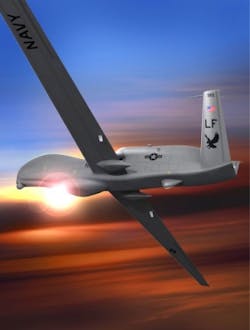Northrop Grumman to develop common UAV ground control stations for Global Hawk and BAMS reconnaissance craft
The Northrop Grumman RQ-4N BAMS, meanwhile, is a multi-mission maritime intelligence, surveillance, and reconnaissance (ISR) system designed to support strike, signals intelligence, and communications relay duties while operating independently or with other Navy aircraft, surface warships, or submarines.
Navy officials expect BAMS to fulfill part of the long-range maritime patrol and anti-submarine warfare mission that historically has been the role of the P-3 Orion four-engine turboprop aircraft. The UAV will complement the Navy's future Boeing P-8 Poseidon maritime multi-mission aircraft (MMA).
Working together with the P-8 Poseidon, the BAMS UAV primarily would handle high-altitude surveillance, signals intelligence, and communications relay tasks, while the P-8 -- a specially designed version of the Boeing 737 passenger jetliner -- would handle low-altitude reconnaissance, attack, and anti-submarine warfare duties.
BAMS would operate at altitudes higher than 40,000 feet, above the weather and most air traffic, to conduct continuous open-ocean and littoral surveillance of targets as small as exposed submarine periscopes.
For questions or concerns about the Navy's impending contract to Northrop Grumman to develop a common UAV ground control station for BAMS and Global Hawk, contact the Navy's Charles Poston by phone at 301-757-5955, or by e-mail at [email protected]. Also contact the Navy's Kelly Chism by phone at 301-757-5896, or by e-mail at [email protected].
More information is online at https://www.fbo.gov/spg/DON/NAVAIR/N00421/N00019-11-R-0042/listing.html.
About the Author
John Keller
Editor-in-Chief
John Keller is the Editor-in-Chief, Military & Aerospace Electronics Magazine--provides extensive coverage and analysis of enabling electronics and optoelectronic technologies in military, space and commercial aviation applications. John has been a member of the Military & Aerospace Electronics staff since 1989 and chief editor since 1995.
